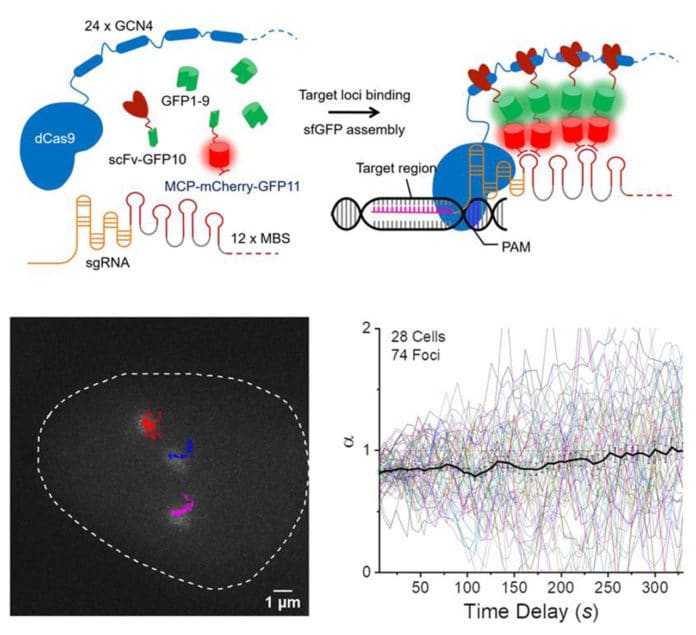CRISPR, also known as CRISPR/Cas9, is a type of gene-editing technology that has been used to correct specific disease-causing DNA mutations. It consists of two components: the Cas9 enzyme that functions as a pair of molecular scissors and a guide RNA (gRNA or sgRNA), which guides the Cas9 to the planned part of the genome the right place is cut.
In recent years, Genome imaging based on the CRISPR system has attracted strong interest. It is a powerful approach yet has limited applicability due to background signals and non-specific aggregation of fluorophores within nuclei.
UNIST scientists solved this issue by developing a novel CRISPR-based genome labeling scheme for reliable visualization of genomic loci in live cells for an extended time. This labeling scheme allows the detection of genomic loci with a significantly reduced background level and high target specificity, thus enables successful tracking of genomic loci with a small number of sequence repeats in live cells.
To develop this scheme, scientists integrated tripartite superfolder green fluorescent protein (sfGFP) and the SunTag system into a CRISPR complex design.
Chromatin is a complex of genomic DNA and proteins that form chromosomes within the nucleus of eukaryotic cells.
In recent years, there has been a growing interest in the study of chromatin structure and dynamics. Several studies have shown that aging is associated with changes in gene expression and chromatin structure and that in many cases, including cancer.
But, to track the movements of chromatin in real-time, the development of new methods is necessary.
The research team presented a new visualization scheme in their study, combining tripartite fluorescent proteins with the SunTag system and demonstrated that it strongly suppressed background fluorescence and amplified locus-specific signals, allowing long-term tracking of genomic loci. Besides, with fluorescence analysis, the location and shape of DNA can also be determined.
Scientists also integrated the multicomponent CRISPR system into stable cell lines to allow quantitative and reliable analysis of dynamic behaviors of genomic loci.
Due to the significantly elevated signal-to-background ratio, target loci with only small numbers of sequence repeats could be successfully tracked, even under a conventional fluorescence microscope. This feature enables the application of CRISPR-based imaging to loci throughout the genome and opens up new possibilities for studying nuclear processes in living cells.
Narendra Chaudhary, the first author of the study, said, “They also confirmed that DNA not only diffuses passively, as the ink spreads in water but also moves actively. This has been verified via long-term tracking of the movement of specific regions of DNA, using the newly-developed genome imaging technique. Due to the thread-like structure of DNA, we expected it to show sub-diffusion when there is no active movement, but herein via long-term tracking of the C9-1 loci, we observed super-diffusion behavior.”
Until now, it has been known that DNA does not act indirectly on other molecules. Rather, various enzymes act on DNA and copy its information into either more DNA, in DNA replication, or transcribe it into protein. Likewise, the enzymes in DNA repair pathways that act upon the damaged DNA substrate allow for the genetic information stored in the DNA to be expressed in the cell’s physical and functional makeup.
Journal Reference:
- Narendra Chaudhary, Si-Hyeong Nho, Hayoon Cho, et al., “Background-suppressed live visualization of genomic loci with an improved CRISPR system based on a split fluorophore,” Genome Research, (2020). DOI: 10.1101/gr.260018.119
